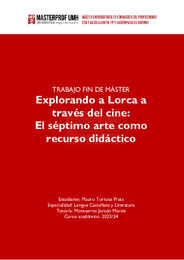Please use this identifier to cite or link to this item:
https://hdl.handle.net/11000/32878Full metadata record
| DC Field | Value | Language |
|---|---|---|
| dc.contributor.advisor | Jurado Martín, Montserrat | - |
| dc.contributor.author | Tortosa Prats, Mauro | - |
| dc.contributor.other | Departamentos de la UMH::Ciencias Sociales y Humanas | es_ES |
| dc.date.accessioned | 2024-08-02T10:02:55Z | - |
| dc.date.available | 2024-08-02T10:02:55Z | - |
| dc.date.created | 2024 | - |
| dc.identifier.uri | https://hdl.handle.net/11000/32878 | - |
| dc.description | Especialidad: Lengua castellana y literatura | es_ES |
| dc.description.abstract | Históricamente el cine ha sido considerado un agente socializador de gran potencia, al exhibir patrones de conducta, producir reacciones y transmitir valores y creencias. No obstante, en la actualidad numerosos autores lo sitúan como un fiel testigo del mundo, transformándose en un espejo que proyecta la realidad social y contribuye activamente a la edificación del conocimiento colectivo. La propuesta de este artículo tiene como objetivo investigar diversas adaptaciones cinematográficas y documentales tomando una muestra de estudio a partir de la base de datos Mar de lunas. Federico García Lorca. Una filmografía en construcción de Rafael Utrera Macías, que sirvan de repositorio documental para explorar la figura del granadino, siempre teniendo como referencia los requisitos curriculares de la asignatura de Lengua Castellana y Literatura de Segundo de Bachillerato. Para ello, se establece una conexión entre las competencias específicas del currículo educativo del curso y las producciones audiovisuales, mediante un total de siete actividades que vinculan la visualización de estos contenidos con los conocimientos que se espera adquirir durante este itinerario. Las temáticas de las nueve producciones analizadas se basan en la trilogía rural del poeta: Bodas de sangre, La casa de Bernarda Alba y Yerma. Palabras | es_ES |
| dc.description.abstract | Historically, cinema has been considered a powerful socialising agent, exhibiting patterns of behaviour, producing reactions and transmitting values and beliefs. However, nowadays, many authors see it as a faithful witness of the world, becoming a mirror that projects social reality and actively contributes to the construction of collective knowledge. The aim of this article is to investigate different film and documentary adaptations by taking a study sample from the database Mar de lunas. Federico García Lorca. A filmography under construction by Rafael Utrera Macías, which serve as a documentary repository to explore the figure of the Granada-born writer, always taking as a reference the curricular requirements of the subject of Spanish Language and Literature of the Second Baccalaureate. To this end, a connection is established between the specific competences of the educational curriculum of the course and the audiovisual productions, through a total of seven activities that link the viewing of these contents with the knowledge that is expected to be acquired during this itinerary. The themes of the nine productions analysed are based on the poet's rural trilogy: Bodas de sangre, La casa de Bernarda Alba and Yerma. | - |
| dc.format | application/pdf | es_ES |
| dc.format.extent | 30 | es_ES |
| dc.language.iso | spa | es_ES |
| dc.publisher | Universidad Miguel Hernández de Elche | es_ES |
| dc.rights | info:eu-repo/semantics/openAccess | es_ES |
| dc.rights.uri | http://creativecommons.org/licenses/by-nc-nd/4.0/ | * |
| dc.subject | Federico García Lorca | es_ES |
| dc.subject | Recurso didáctico | es_ES |
| dc.subject | Cine | es_ES |
| dc.subject | Lengua castellana | es_ES |
| dc.subject | Literatura | es_ES |
| dc.title | Explorando a Lorca a través del cine: El séptimo arte como recurso didáctico | es_ES |
| dc.type | info:eu-repo/semantics/masterThesis | es_ES |

View/Open:
TORTOSA PRATS, MAURO.pdf
1,14 MB
Adobe PDF
Share:
.png)
